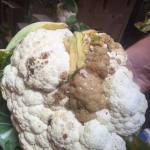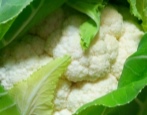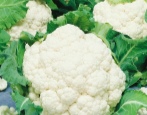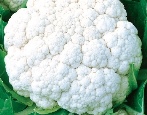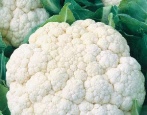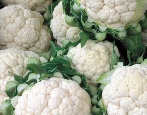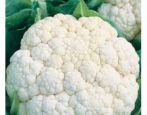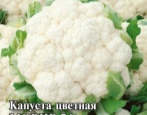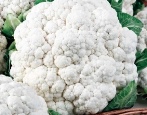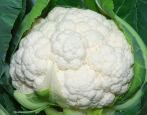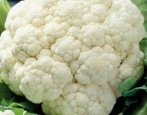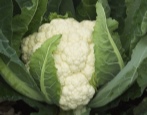
- Authors: Maksimov S.V., Klimenko N.N.
- Year of approval: 2009
- Appointment: for home cooking, for freezing, for canning, for fresh consumption
- Leaf rosette: raised
- Sheet length: middle length
- Leaf color: blue-green, with a slight waxy bloom
- Sheet surface: slightly bubbly
- Leaf edge: slightly wavy
- Yield: high
- Average yield: 3.5 kg / sq.m
Cauliflower occupies a special place on the plot of summer residents. The species is distinguished by taste, ripening times, as well as productivity. Cauliflower Alpha is considered one of the best varieties.
Breeding history
Alfa cabbage was developed in 2007 by Russian breeders S. V. Maksimov and N. N. Klimenko. The originator was the agrofirm "Poisk". By mid-summer 2008, the company submits an application for entry into the State Register, and in 2009 the variety was approved for use.
Description of the variety
The culture is intended for growing in the open field, while it has a good immunity to temperature extremes and a slight cold snap.
The other advantages of the variety include long-term fruiting. Cabbage is unpretentious to care for, so even a beginner can handle it. They note the excellent density of the heads of cabbage, as well as the taste of the cabbage. The culture has excellent keeping rates, thanks to which it can be transported over long distances.
Among the minuses, it can be noted that cabbage is very demanding on the mineral component of the soil and on care (in particular, for watering).
Characterization of the appearance of the plant and heads
The rosette of leaves is raised. Leaves are elliptical in shape, of medium length.
In color, the leaf plate is blue-green, with a weak waxy bloom. The surface is slightly bumpy, the veins are weak. The edge of the leaf is slightly wavy. Plant height can reach 30-45 cm.
The head is large, rounded, weighing 1.2 kg. It is whitish in color, medium hilly, very dense. Partial leaf coverage.
The texture of the inflorescences is delicate, juicy and crunchy.
Purpose and taste
Cabbage has a universal purpose, therefore it is suitable for fresh consumption, for home cooking (making soups, mashed potatoes, side dishes), for freezing, canning and pickling.
Alpha has a sweet taste, no bitterness. The composition is also dominated by such vitamins as potassium, folic acid, carotene and ascorbic acid.
Ripening terms
The culture is early maturing, the vegetative period takes on average 80-90 days. Maturation of all heads is amicable, as is the harvest.
Yield
Cauliflower Alpha has a high yield. On average, 3.5 kg can be removed from 1 m2, provided that all agrotechnical care has been followed.
Growing and care
The best place to grow cabbage is on the sunny side. Previously, cucumbers, pumpkins and legumes could be grown there.
It is not advisable to grow seedlings near crops such as radishes, turnips, or other cruciferous plants. These plants have the same diseases.
Cabbage is grown in two ways: seed and seedling. The seed method is suitable for regions with a favorable, mild and very warm climate, or for germination in warm greenhouses.
The second method (seedling) is one of the most popular, since weather conditions in many parts of Russia are not fixed, and frosts can occur.
Sowing for seedlings is carried out from March 20 to April 10. Seedling containers are preliminarily prepared, processed and disinfected. Earth is poured into them, which is sprayed with a weak solution of manganese.
At this time, it is best to soak the seeds in warm water (temperature no more than 40 ° C) for 30-40 minutes. Then the material should be cooled in cold water for 3 minutes.
Sowing is carried out in separate containers, 3 seeds in 1 pot.
For the emergence of good shoots, the room temperature should be + 18 ° C.
The preparation of the beds should be done in the fall. When digging into the ground, humus and ash are added.
In the spring, the site is processed again, with the addition of ammonium nitrate and sulfate. The distance at the time of planting seedlings should be 50x30 cm.
Watering should be carried out depending on weather conditions. Young seedlings are not so demanding on water, so it is better to irrigate them once every 5 days. In the active phase of the vegetative period, it is best to increase the procedure up to 2 times, but provided that the soil dries well, at least 15 cm. Watering is recommended strictly after sunset.
Loosening is carried out immediately after irrigation. At this moment, the ground is soft and pliable, dry lumps fall apart more actively. It is worth loosening to a depth of no more than 10 cm.
Top dressing is carried out 3 times in one season. 8-10 days after transplanting, the seedlings are fed with nitrogen-containing fertilizers. The second is carried out after 25 days - with urea and wood ash. The latter - at the time of maturation of the head, a mineral complex is chosen as a fertilizer.
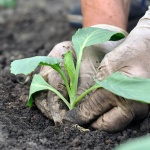
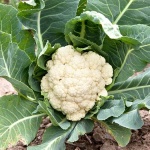
Disease and pest resistance
Cauliflower Alpha has good immunity to common diseases (such as keela or blackleg). But with the wrong care, the culture can develop other diseases.
Vascular bacteriosis. It can appear at any stage of cabbage ripening. With an ailment, crop yield, juiciness and useful properties fall. First of all, the leaves begin to turn yellow, and the veins turn black. For the fight use the drug "Planriz".
The cruciferous flea is a pest that spreads very quickly throughout the outlet and leaves and causes damage in a matter of days. To prevent the spread of the insect, the leaves should be inspected every day. And also, if detected, use the drug "Aktar".
